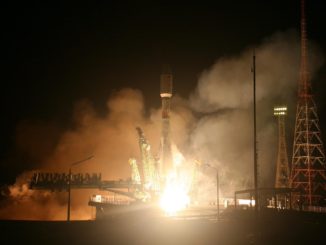STORY WRITTEN FOR CBS NEWS & USED WITH PERMISSION

Two cosmonauts and a NASA astronaut undocked from the International Space Station and plunged back to Earth early Saturday, landing on the steppe of Kazakhstan amid preparations in Florida for launch of another station-bound crew Thursday aboard a SpaceX Crew Dragon spacecraft.
With Russian recovery forces and NASA support personnel standing by, the Soyuz spacecraft’s central crew module, descending under a single orange-and-white parachute, settled to an on target rocket-assisted touchdown at 12:55 a.m. EDT (10:55 a.m. local time) to close out a 185-day mission.
Soyuz MS-17/63S commander Sergey Ryzhikov, flight engineer Sergey Kud-Sverchkov and NASA astronaut Kate Rubins waved, smiled broadly and high-fived support crews as they were carried from the capsule to nearby recliners for quick medical checks and satellite phone calls home to friends and family.
“It was awesome!” Rubins, a space veteran, exclaimed after her second Soyuz re-entry.
At the Kennedy Space Center in Florida, meanwhile, SpaceX engineers readied a Falcon 9 rocket for a first stage engine test firing early Saturday to set the stage for launch Thursday on a flight to ferry two NASA astronauts, a Frenchman and a Japanese astronaut to the space station for their own six-month stay.
The four “Crew-2” astronauts flew to the Florida spaceport Friday afternoon to prepare for flight.
“It is awesome being at Kennedy Space Center, especially on launch week,” commander Shane Kimbrough told reporters at the runway. “It’s definitely getting real. Our crew is extremely well trained (and) we are really excited and ready to go.”

The Soyuz landing and Crew Dragon launch are the second and third flights in a record four-mission sequence over just three weeks to replace the station’s entire seven-member crew after long-duration stays in orbit.
It began on April 9 when Soyuz MS-18/64S commander Oleg Novitskiy, Pyotr Dubrov and NASA’s Mark Vande Hei blasted off from the Baikonur Cosmodrome in Kazakhstan, docking at the station after a two-orbit rendezvous.
They have now replaced Ryzhikov, Kud-Sverchkov and Rubins, who were launched to the orbital outpost last October. After a six-day handover, the outgoing trio bid their station crewmates farewell and undocked from the lab complex at 9:34 p.m. Friday
A four-minute 39-second rocket firing slowed the ship enough to drop out of orbit and 50 minutes later, the descent module landed as planned near the town of Dzhezkazgan.
Russian helicopters were standing by to ferry the crew to Karaganda. From there, Ryzhikov and Kud-Sverchkov planned to board a Russian jet for a flight back to Star City near Moscow while Rubins headed home to Houston aboard a NASA aircraft.
With the Soyuz crew safely back on Earth, NASA and SpaceX engineers are pressing ahead with work to ready the Falcon 9 rocket and Crew Dragon spacecraft for launch Thursday.
It will be the third piloted launch to orbit from U.S. soil since the shuttle program’s final flight in 2011 and the first featuring a previously flown first-stage booster and Crew Dragon ferry ship.
Following Saturday’s engine test firing, Kimbrough, McArthur, Pesquet and Hoshide plan to strap in early Sunday for a dress rehearsal countdown to run through launch-day procedures.
Liftoff is scheduled for 6:11 a.m. Thursday, setting up a docking at the space station Friday morning.
Kimbrough and his crew will be welcomed aboard the lab by space station commander Shannon Walker and fellow Crew Dragon astronauts Michael Hopkins, Victor Glover and Japanese astronaut Soichi Noguchi, along with Novitskiy, Dubrov and Vande Hei.
After a weeklong handover to help familiarize their replacements with station operations, the Crew-1 astronauts will depart, riding their SpaceX capsule to a splashdown in the Gulf of Mexico south of Tallahassee, Florida, around 12:40 p.m. on April 28.
And with that, NASA and the Russian space agency Roscosmos will have replaced the station’s seven crew members with two launches and two landings in less than one month, a record pace for the space station program.



